KPMG's Strategic Management: Business Analysis and Planning Report
VerifiedAdded on 2023/06/08
|12
|3987
|256
Report
AI Summary
This report provides a detailed strategic management plan focused on KPMG, analyzing the impact of the macro environment using frameworks like PESTLE, evaluating internal capabilities with models like McKinsey's 7s and VRIO, and assessing competitive forces through Porter's Five Forces. The analysis covers demographic, economic, political, ecological, socio-cultural, and technological factors influencing KPMG's strategies. It also explores internal strengths, weaknesses, opportunities, and threats through SWOT analysis. The report further interprets and devises strategic planning for KPMG, incorporating benchmarking and business analysis techniques to enhance the organization's competitive position and overall business strategy.
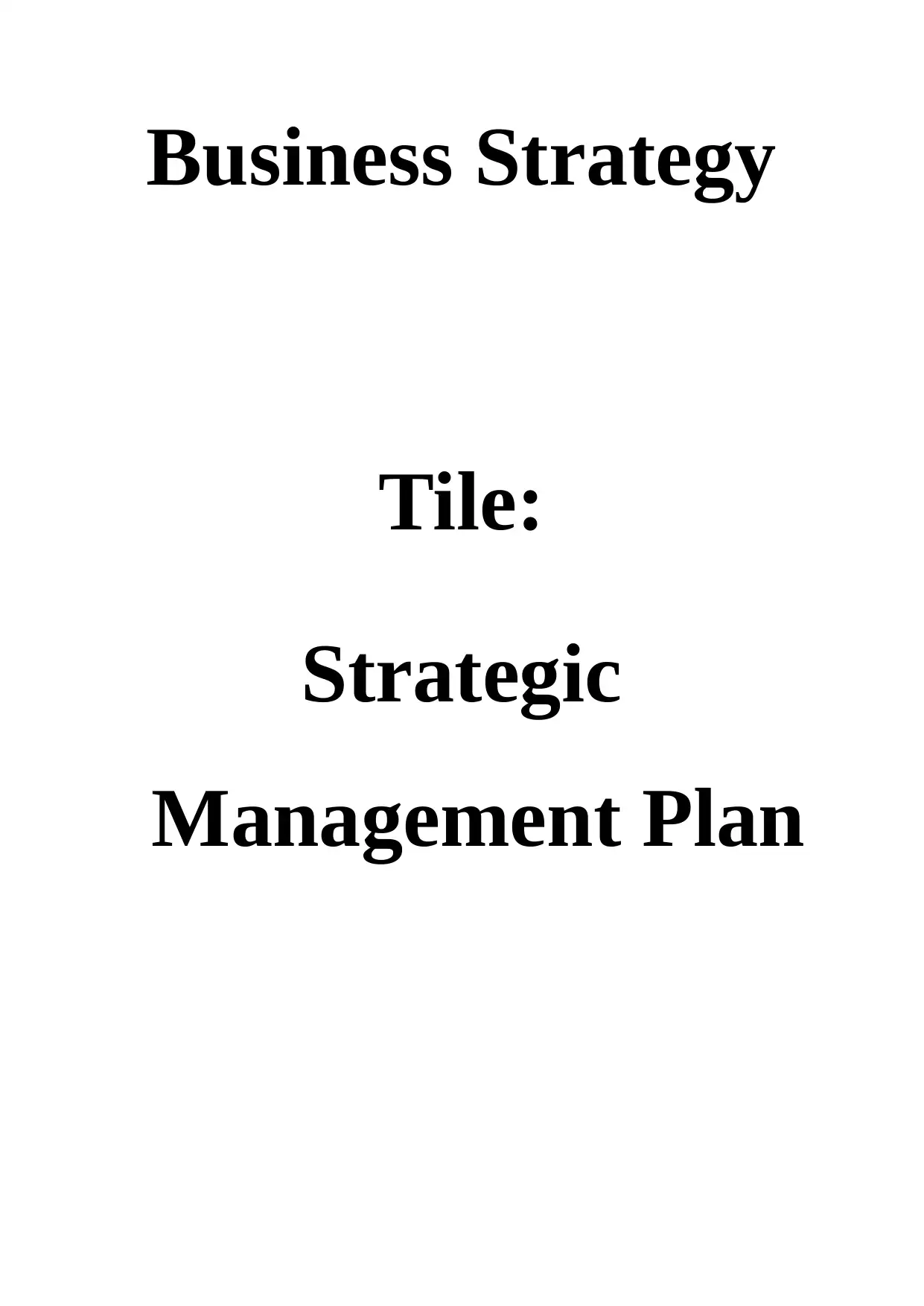
Business Strategy
Tile:
Strategic
Management Plan
Tile:
Strategic
Management Plan
Paraphrase This Document
Need a fresh take? Get an instant paraphrase of this document with our AI Paraphraser
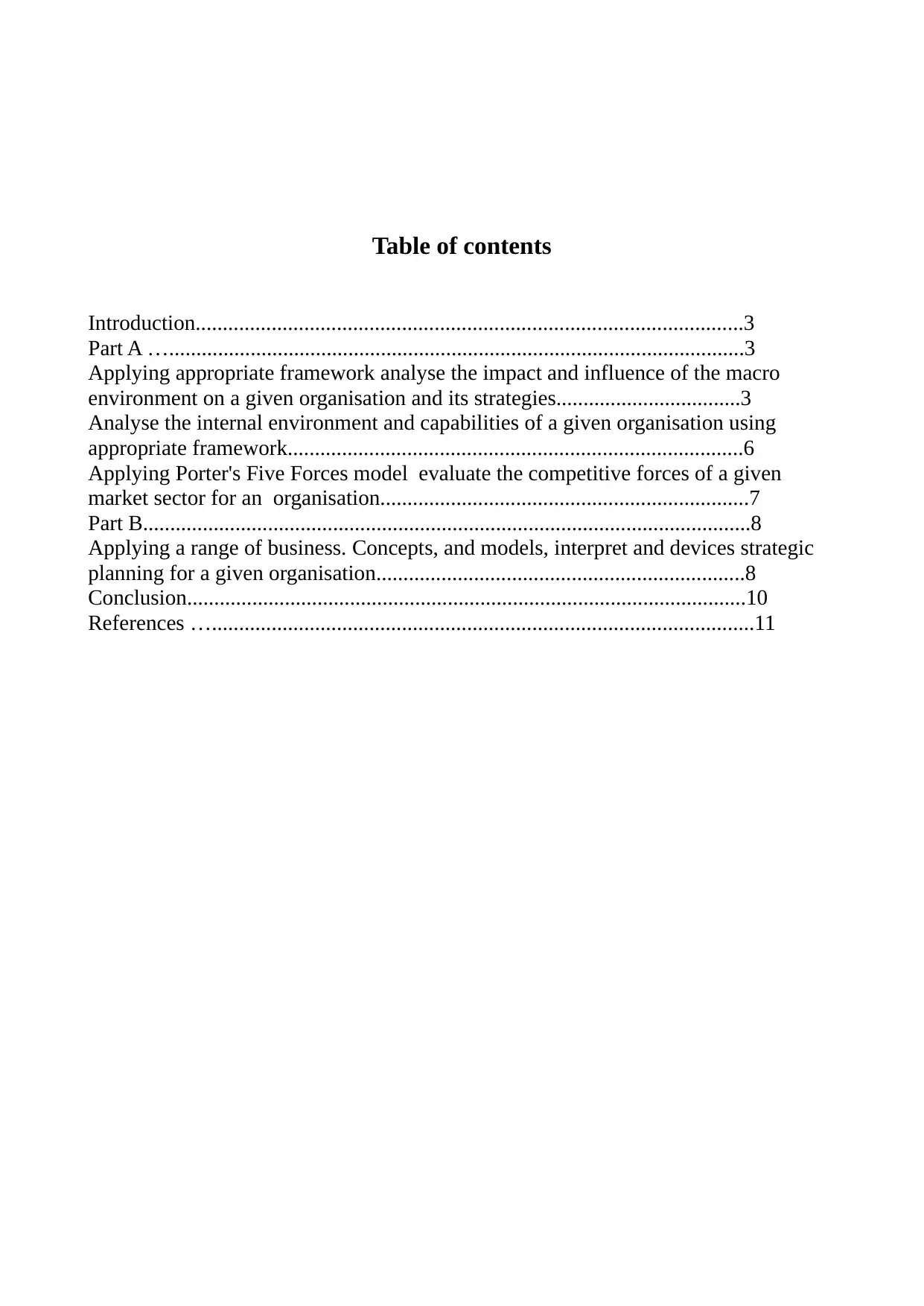
Table of contents
Introduction.....................................................................................................3
Part A …..........................................................................................................3
Applying appropriate framework analyse the impact and influence of the macro
environment on a given organisation and its strategies..................................3
Analyse the internal environment and capabilities of a given organisation using
appropriate framework....................................................................................6
Applying Porter's Five Forces model evaluate the competitive forces of a given
market sector for an organisation....................................................................7
Part B................................................................................................................8
Applying a range of business. Concepts, and models, interpret and devices strategic
planning for a given organisation....................................................................8
Conclusion.......................................................................................................10
References …....................................................................................................11
Introduction.....................................................................................................3
Part A …..........................................................................................................3
Applying appropriate framework analyse the impact and influence of the macro
environment on a given organisation and its strategies..................................3
Analyse the internal environment and capabilities of a given organisation using
appropriate framework....................................................................................6
Applying Porter's Five Forces model evaluate the competitive forces of a given
market sector for an organisation....................................................................7
Part B................................................................................................................8
Applying a range of business. Concepts, and models, interpret and devices strategic
planning for a given organisation....................................................................8
Conclusion.......................................................................................................10
References …....................................................................................................11
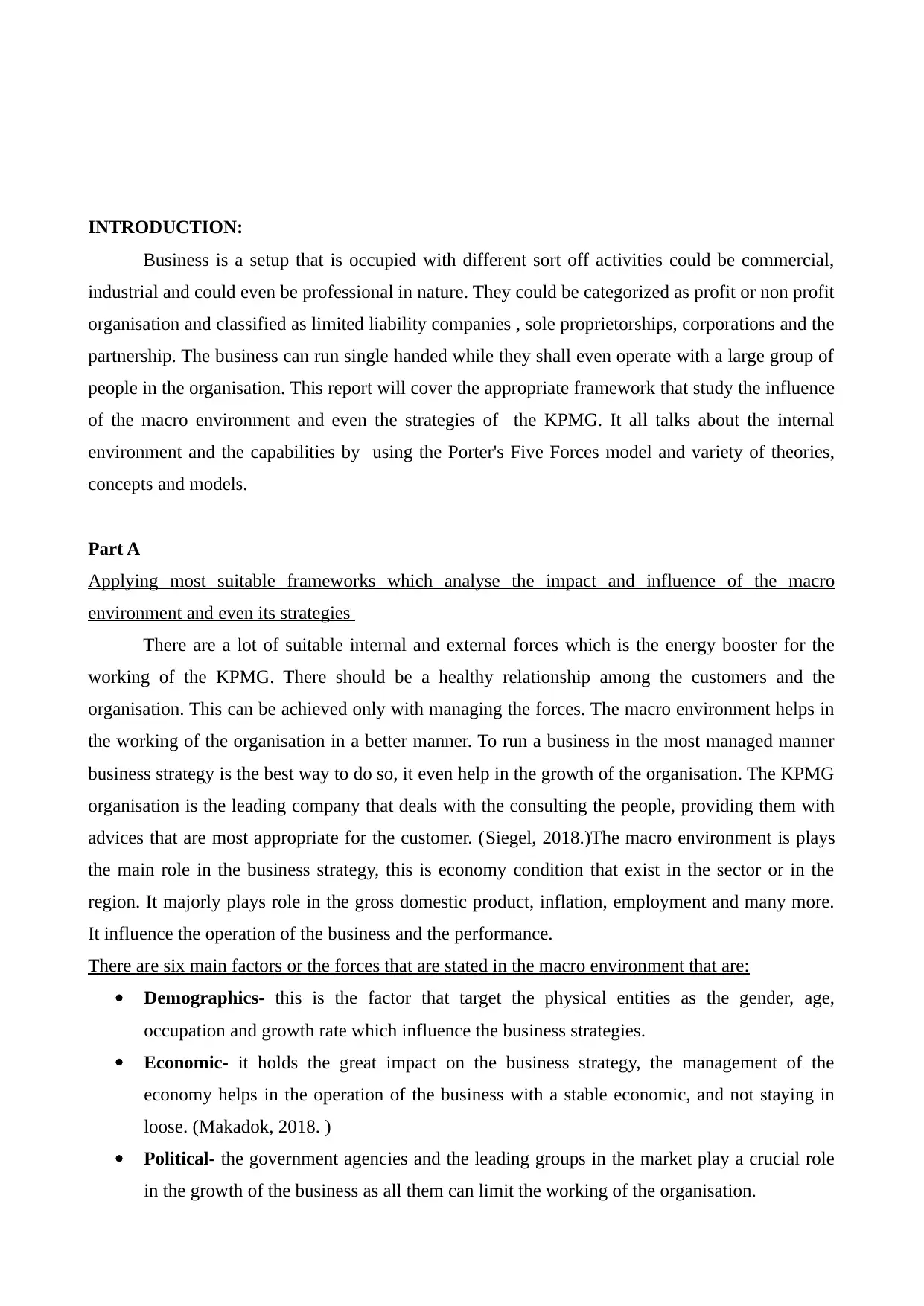
INTRODUCTION:
Business is a setup that is occupied with different sort off activities could be commercial,
industrial and could even be professional in nature. They could be categorized as profit or non profit
organisation and classified as limited liability companies , sole proprietorships, corporations and the
partnership. The business can run single handed while they shall even operate with a large group of
people in the organisation. This report will cover the appropriate framework that study the influence
of the macro environment and even the strategies of the KPMG. It all talks about the internal
environment and the capabilities by using the Porter's Five Forces model and variety of theories,
concepts and models.
Part A
Applying most suitable frameworks which analyse the impact and influence of the macro
environment and even its strategies
There are a lot of suitable internal and external forces which is the energy booster for the
working of the KPMG. There should be a healthy relationship among the customers and the
organisation. This can be achieved only with managing the forces. The macro environment helps in
the working of the organisation in a better manner. To run a business in the most managed manner
business strategy is the best way to do so, it even help in the growth of the organisation. The KPMG
organisation is the leading company that deals with the consulting the people, providing them with
advices that are most appropriate for the customer. (Siegel, 2018.)The macro environment is plays
the main role in the business strategy, this is economy condition that exist in the sector or in the
region. It majorly plays role in the gross domestic product, inflation, employment and many more.
It influence the operation of the business and the performance.
There are six main factors or the forces that are stated in the macro environment that are:
Demographics- this is the factor that target the physical entities as the gender, age,
occupation and growth rate which influence the business strategies.
Economic- it holds the great impact on the business strategy, the management of the
economy helps in the operation of the business with a stable economic, and not staying in
loose. (Makadok, 2018. )
Political- the government agencies and the leading groups in the market play a crucial role
in the growth of the business as all them can limit the working of the organisation.
Business is a setup that is occupied with different sort off activities could be commercial,
industrial and could even be professional in nature. They could be categorized as profit or non profit
organisation and classified as limited liability companies , sole proprietorships, corporations and the
partnership. The business can run single handed while they shall even operate with a large group of
people in the organisation. This report will cover the appropriate framework that study the influence
of the macro environment and even the strategies of the KPMG. It all talks about the internal
environment and the capabilities by using the Porter's Five Forces model and variety of theories,
concepts and models.
Part A
Applying most suitable frameworks which analyse the impact and influence of the macro
environment and even its strategies
There are a lot of suitable internal and external forces which is the energy booster for the
working of the KPMG. There should be a healthy relationship among the customers and the
organisation. This can be achieved only with managing the forces. The macro environment helps in
the working of the organisation in a better manner. To run a business in the most managed manner
business strategy is the best way to do so, it even help in the growth of the organisation. The KPMG
organisation is the leading company that deals with the consulting the people, providing them with
advices that are most appropriate for the customer. (Siegel, 2018.)The macro environment is plays
the main role in the business strategy, this is economy condition that exist in the sector or in the
region. It majorly plays role in the gross domestic product, inflation, employment and many more.
It influence the operation of the business and the performance.
There are six main factors or the forces that are stated in the macro environment that are:
Demographics- this is the factor that target the physical entities as the gender, age,
occupation and growth rate which influence the business strategies.
Economic- it holds the great impact on the business strategy, the management of the
economy helps in the operation of the business with a stable economic, and not staying in
loose. (Makadok, 2018. )
Political- the government agencies and the leading groups in the market play a crucial role
in the growth of the business as all them can limit the working of the organisation.
⊘ This is a preview!⊘
Do you want full access?
Subscribe today to unlock all pages.

Trusted by 1+ million students worldwide
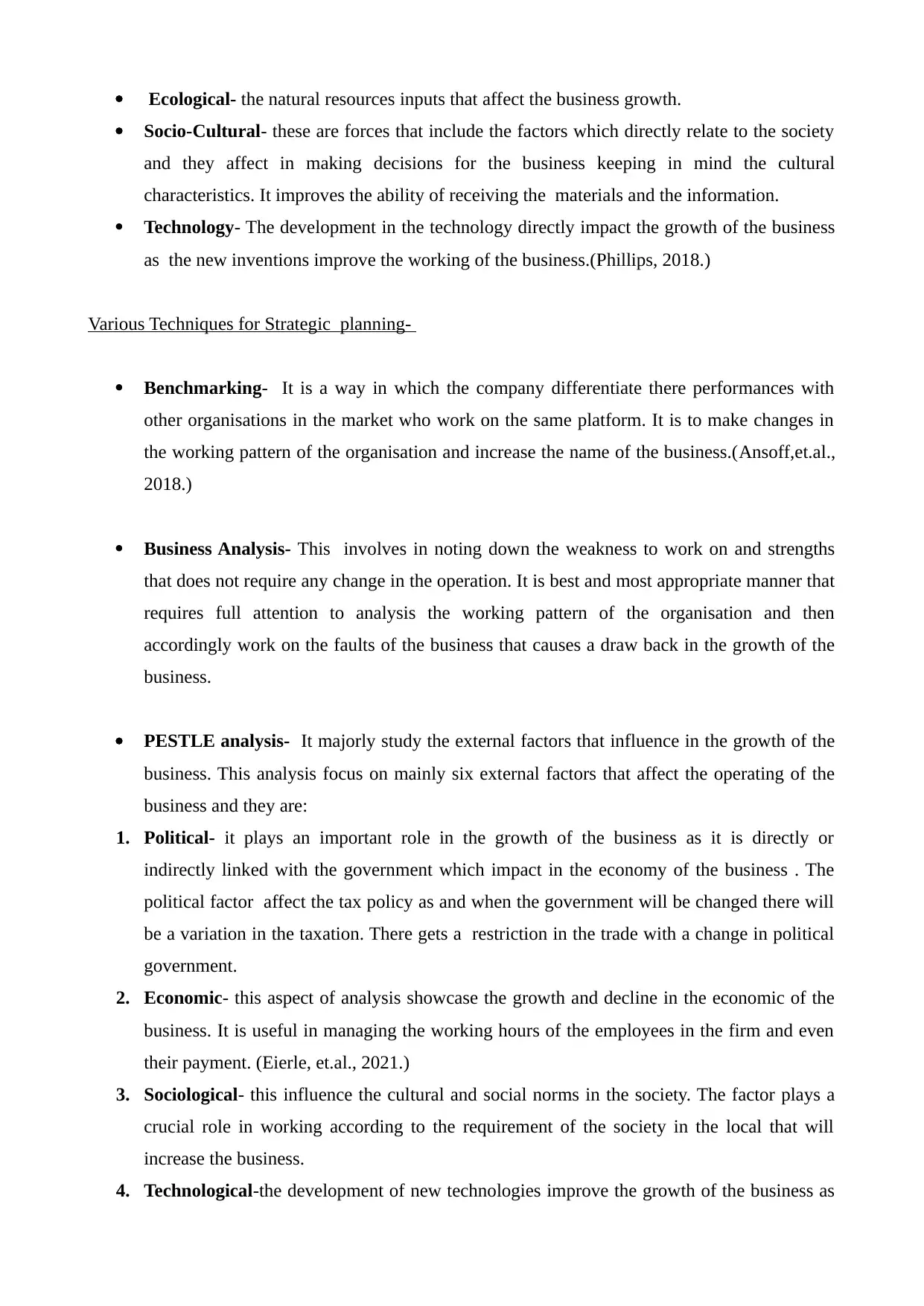
Ecological- the natural resources inputs that affect the business growth.
Socio-Cultural- these are forces that include the factors which directly relate to the society
and they affect in making decisions for the business keeping in mind the cultural
characteristics. It improves the ability of receiving the materials and the information.
Technology- The development in the technology directly impact the growth of the business
as the new inventions improve the working of the business.(Phillips, 2018.)
Various Techniques for Strategic planning-
Benchmarking- It is a way in which the company differentiate there performances with
other organisations in the market who work on the same platform. It is to make changes in
the working pattern of the organisation and increase the name of the business.(Ansoff,et.al.,
2018.)
Business Analysis- This involves in noting down the weakness to work on and strengths
that does not require any change in the operation. It is best and most appropriate manner that
requires full attention to analysis the working pattern of the organisation and then
accordingly work on the faults of the business that causes a draw back in the growth of the
business.
PESTLE analysis- It majorly study the external factors that influence in the growth of the
business. This analysis focus on mainly six external factors that affect the operating of the
business and they are:
1. Political- it plays an important role in the growth of the business as it is directly or
indirectly linked with the government which impact in the economy of the business . The
political factor affect the tax policy as and when the government will be changed there will
be a variation in the taxation. There gets a restriction in the trade with a change in political
government.
2. Economic- this aspect of analysis showcase the growth and decline in the economic of the
business. It is useful in managing the working hours of the employees in the firm and even
their payment. (Eierle, et.al., 2021.)
3. Sociological- this influence the cultural and social norms in the society. The factor plays a
crucial role in working according to the requirement of the society in the local that will
increase the business.
4. Technological-the development of new technologies improve the growth of the business as
Socio-Cultural- these are forces that include the factors which directly relate to the society
and they affect in making decisions for the business keeping in mind the cultural
characteristics. It improves the ability of receiving the materials and the information.
Technology- The development in the technology directly impact the growth of the business
as the new inventions improve the working of the business.(Phillips, 2018.)
Various Techniques for Strategic planning-
Benchmarking- It is a way in which the company differentiate there performances with
other organisations in the market who work on the same platform. It is to make changes in
the working pattern of the organisation and increase the name of the business.(Ansoff,et.al.,
2018.)
Business Analysis- This involves in noting down the weakness to work on and strengths
that does not require any change in the operation. It is best and most appropriate manner that
requires full attention to analysis the working pattern of the organisation and then
accordingly work on the faults of the business that causes a draw back in the growth of the
business.
PESTLE analysis- It majorly study the external factors that influence in the growth of the
business. This analysis focus on mainly six external factors that affect the operating of the
business and they are:
1. Political- it plays an important role in the growth of the business as it is directly or
indirectly linked with the government which impact in the economy of the business . The
political factor affect the tax policy as and when the government will be changed there will
be a variation in the taxation. There gets a restriction in the trade with a change in political
government.
2. Economic- this aspect of analysis showcase the growth and decline in the economic of the
business. It is useful in managing the working hours of the employees in the firm and even
their payment. (Eierle, et.al., 2021.)
3. Sociological- this influence the cultural and social norms in the society. The factor plays a
crucial role in working according to the requirement of the society in the local that will
increase the business.
4. Technological-the development of new technologies improve the growth of the business as
Paraphrase This Document
Need a fresh take? Get an instant paraphrase of this document with our AI Paraphraser
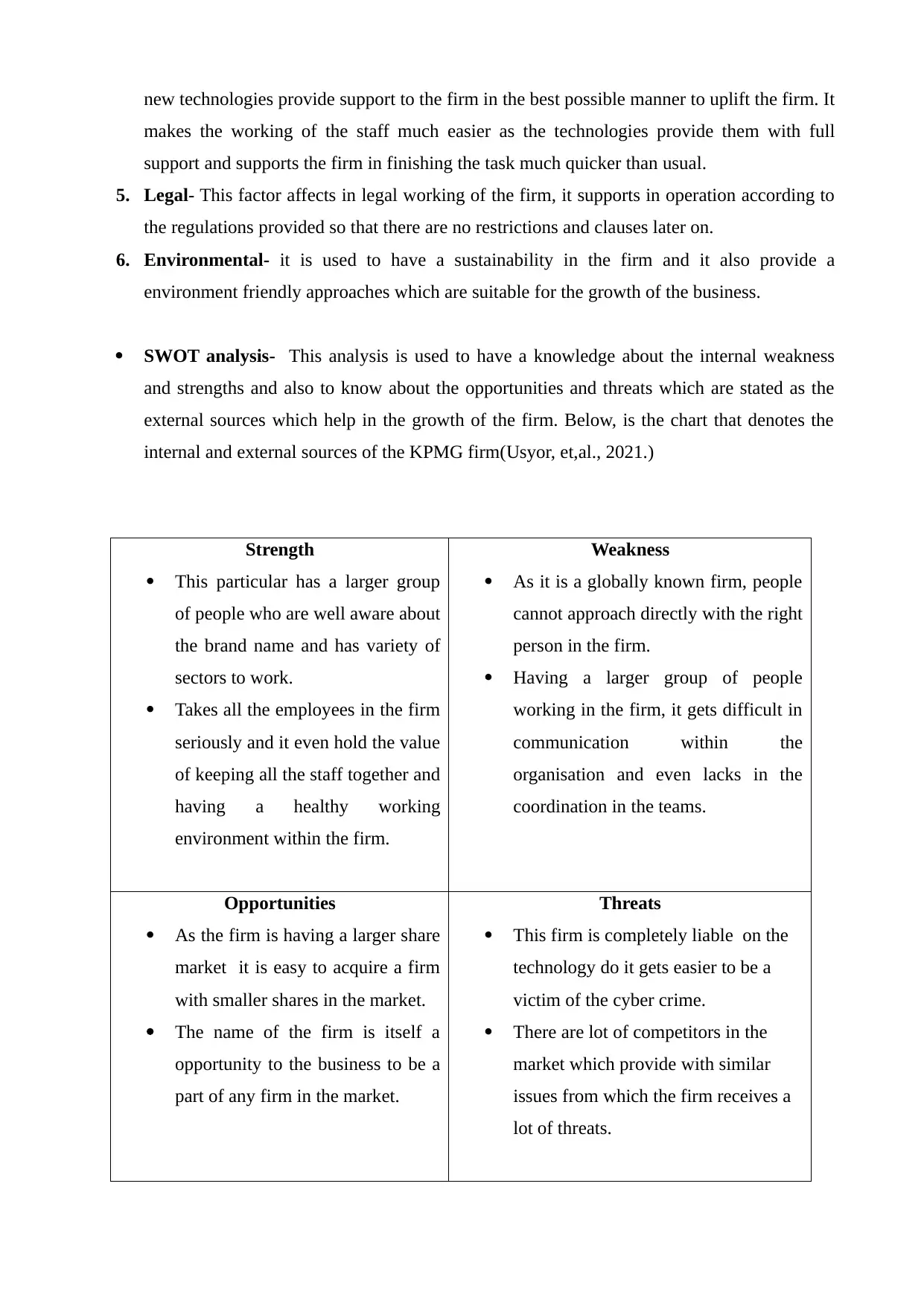
new technologies provide support to the firm in the best possible manner to uplift the firm. It
makes the working of the staff much easier as the technologies provide them with full
support and supports the firm in finishing the task much quicker than usual.
5. Legal- This factor affects in legal working of the firm, it supports in operation according to
the regulations provided so that there are no restrictions and clauses later on.
6. Environmental- it is used to have a sustainability in the firm and it also provide a
environment friendly approaches which are suitable for the growth of the business.
SWOT analysis- This analysis is used to have a knowledge about the internal weakness
and strengths and also to know about the opportunities and threats which are stated as the
external sources which help in the growth of the firm. Below, is the chart that denotes the
internal and external sources of the KPMG firm(Usyor, et,al., 2021.)
Strength
This particular has a larger group
of people who are well aware about
the brand name and has variety of
sectors to work.
Takes all the employees in the firm
seriously and it even hold the value
of keeping all the staff together and
having a healthy working
environment within the firm.
Weakness
As it is a globally known firm, people
cannot approach directly with the right
person in the firm.
Having a larger group of people
working in the firm, it gets difficult in
communication within the
organisation and even lacks in the
coordination in the teams.
Opportunities
As the firm is having a larger share
market it is easy to acquire a firm
with smaller shares in the market.
The name of the firm is itself a
opportunity to the business to be a
part of any firm in the market.
Threats
This firm is completely liable on the
technology do it gets easier to be a
victim of the cyber crime.
There are lot of competitors in the
market which provide with similar
issues from which the firm receives a
lot of threats.
makes the working of the staff much easier as the technologies provide them with full
support and supports the firm in finishing the task much quicker than usual.
5. Legal- This factor affects in legal working of the firm, it supports in operation according to
the regulations provided so that there are no restrictions and clauses later on.
6. Environmental- it is used to have a sustainability in the firm and it also provide a
environment friendly approaches which are suitable for the growth of the business.
SWOT analysis- This analysis is used to have a knowledge about the internal weakness
and strengths and also to know about the opportunities and threats which are stated as the
external sources which help in the growth of the firm. Below, is the chart that denotes the
internal and external sources of the KPMG firm(Usyor, et,al., 2021.)
Strength
This particular has a larger group
of people who are well aware about
the brand name and has variety of
sectors to work.
Takes all the employees in the firm
seriously and it even hold the value
of keeping all the staff together and
having a healthy working
environment within the firm.
Weakness
As it is a globally known firm, people
cannot approach directly with the right
person in the firm.
Having a larger group of people
working in the firm, it gets difficult in
communication within the
organisation and even lacks in the
coordination in the teams.
Opportunities
As the firm is having a larger share
market it is easy to acquire a firm
with smaller shares in the market.
The name of the firm is itself a
opportunity to the business to be a
part of any firm in the market.
Threats
This firm is completely liable on the
technology do it gets easier to be a
victim of the cyber crime.
There are lot of competitors in the
market which provide with similar
issues from which the firm receives a
lot of threats.
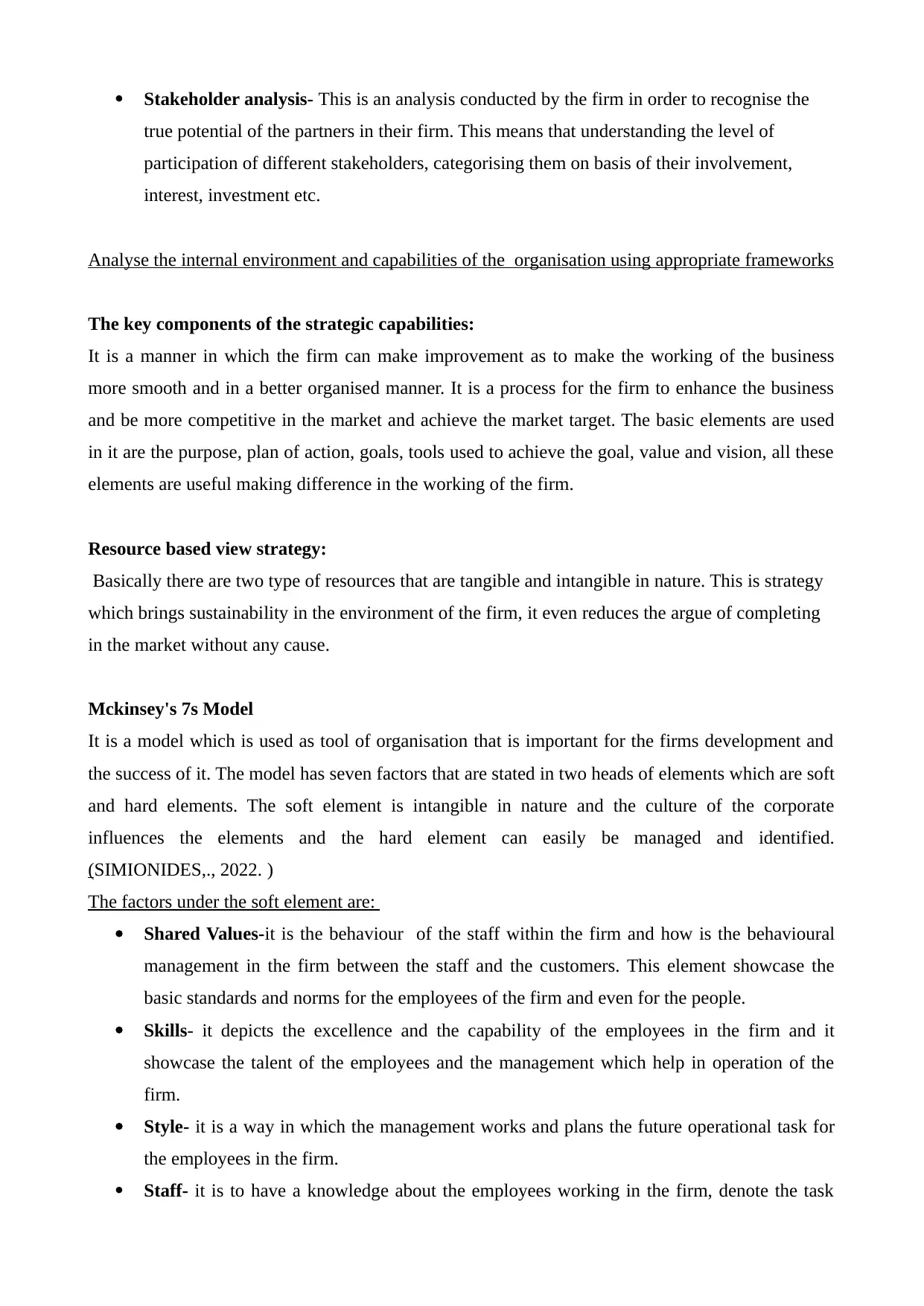
Stakeholder analysis- This is an analysis conducted by the firm in order to recognise the
true potential of the partners in their firm. This means that understanding the level of
participation of different stakeholders, categorising them on basis of their involvement,
interest, investment etc.
Analyse the internal environment and capabilities of the organisation using appropriate frameworks
The key components of the strategic capabilities:
It is a manner in which the firm can make improvement as to make the working of the business
more smooth and in a better organised manner. It is a process for the firm to enhance the business
and be more competitive in the market and achieve the market target. The basic elements are used
in it are the purpose, plan of action, goals, tools used to achieve the goal, value and vision, all these
elements are useful making difference in the working of the firm.
Resource based view strategy:
Basically there are two type of resources that are tangible and intangible in nature. This is strategy
which brings sustainability in the environment of the firm, it even reduces the argue of completing
in the market without any cause.
Mckinsey's 7s Model
It is a model which is used as tool of organisation that is important for the firms development and
the success of it. The model has seven factors that are stated in two heads of elements which are soft
and hard elements. The soft element is intangible in nature and the culture of the corporate
influences the elements and the hard element can easily be managed and identified.
(SIMIONIDES,., 2022. )
The factors under the soft element are:
Shared Values-it is the behaviour of the staff within the firm and how is the behavioural
management in the firm between the staff and the customers. This element showcase the
basic standards and norms for the employees of the firm and even for the people.
Skills- it depicts the excellence and the capability of the employees in the firm and it
showcase the talent of the employees and the management which help in operation of the
firm.
Style- it is a way in which the management works and plans the future operational task for
the employees in the firm.
Staff- it is to have a knowledge about the employees working in the firm, denote the task
true potential of the partners in their firm. This means that understanding the level of
participation of different stakeholders, categorising them on basis of their involvement,
interest, investment etc.
Analyse the internal environment and capabilities of the organisation using appropriate frameworks
The key components of the strategic capabilities:
It is a manner in which the firm can make improvement as to make the working of the business
more smooth and in a better organised manner. It is a process for the firm to enhance the business
and be more competitive in the market and achieve the market target. The basic elements are used
in it are the purpose, plan of action, goals, tools used to achieve the goal, value and vision, all these
elements are useful making difference in the working of the firm.
Resource based view strategy:
Basically there are two type of resources that are tangible and intangible in nature. This is strategy
which brings sustainability in the environment of the firm, it even reduces the argue of completing
in the market without any cause.
Mckinsey's 7s Model
It is a model which is used as tool of organisation that is important for the firms development and
the success of it. The model has seven factors that are stated in two heads of elements which are soft
and hard elements. The soft element is intangible in nature and the culture of the corporate
influences the elements and the hard element can easily be managed and identified.
(SIMIONIDES,., 2022. )
The factors under the soft element are:
Shared Values-it is the behaviour of the staff within the firm and how is the behavioural
management in the firm between the staff and the customers. This element showcase the
basic standards and norms for the employees of the firm and even for the people.
Skills- it depicts the excellence and the capability of the employees in the firm and it
showcase the talent of the employees and the management which help in operation of the
firm.
Style- it is a way in which the management works and plans the future operational task for
the employees in the firm.
Staff- it is to have a knowledge about the employees working in the firm, denote the task
⊘ This is a preview!⊘
Do you want full access?
Subscribe today to unlock all pages.

Trusted by 1+ million students worldwide
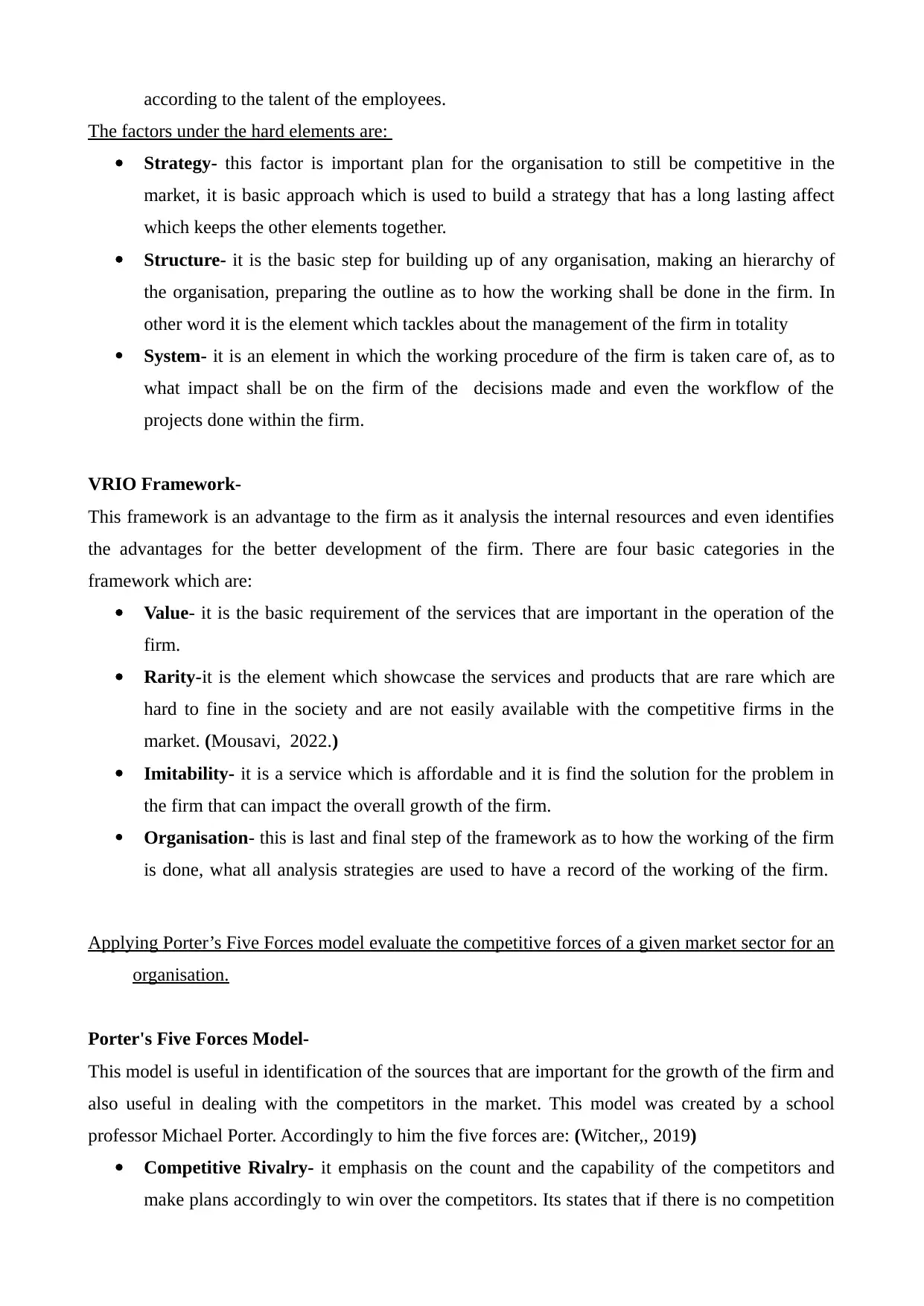
according to the talent of the employees.
The factors under the hard elements are:
Strategy- this factor is important plan for the organisation to still be competitive in the
market, it is basic approach which is used to build a strategy that has a long lasting affect
which keeps the other elements together.
Structure- it is the basic step for building up of any organisation, making an hierarchy of
the organisation, preparing the outline as to how the working shall be done in the firm. In
other word it is the element which tackles about the management of the firm in totality
System- it is an element in which the working procedure of the firm is taken care of, as to
what impact shall be on the firm of the decisions made and even the workflow of the
projects done within the firm.
VRIO Framework-
This framework is an advantage to the firm as it analysis the internal resources and even identifies
the advantages for the better development of the firm. There are four basic categories in the
framework which are:
Value- it is the basic requirement of the services that are important in the operation of the
firm.
Rarity-it is the element which showcase the services and products that are rare which are
hard to fine in the society and are not easily available with the competitive firms in the
market. (Mousavi, 2022.)
Imitability- it is a service which is affordable and it is find the solution for the problem in
the firm that can impact the overall growth of the firm.
Organisation- this is last and final step of the framework as to how the working of the firm
is done, what all analysis strategies are used to have a record of the working of the firm.
Applying Porter’s Five Forces model evaluate the competitive forces of a given market sector for an
organisation.
Porter's Five Forces Model-
This model is useful in identification of the sources that are important for the growth of the firm and
also useful in dealing with the competitors in the market. This model was created by a school
professor Michael Porter. Accordingly to him the five forces are: (Witcher,, 2019)
Competitive Rivalry- it emphasis on the count and the capability of the competitors and
make plans accordingly to win over the competitors. Its states that if there is no competition
The factors under the hard elements are:
Strategy- this factor is important plan for the organisation to still be competitive in the
market, it is basic approach which is used to build a strategy that has a long lasting affect
which keeps the other elements together.
Structure- it is the basic step for building up of any organisation, making an hierarchy of
the organisation, preparing the outline as to how the working shall be done in the firm. In
other word it is the element which tackles about the management of the firm in totality
System- it is an element in which the working procedure of the firm is taken care of, as to
what impact shall be on the firm of the decisions made and even the workflow of the
projects done within the firm.
VRIO Framework-
This framework is an advantage to the firm as it analysis the internal resources and even identifies
the advantages for the better development of the firm. There are four basic categories in the
framework which are:
Value- it is the basic requirement of the services that are important in the operation of the
firm.
Rarity-it is the element which showcase the services and products that are rare which are
hard to fine in the society and are not easily available with the competitive firms in the
market. (Mousavi, 2022.)
Imitability- it is a service which is affordable and it is find the solution for the problem in
the firm that can impact the overall growth of the firm.
Organisation- this is last and final step of the framework as to how the working of the firm
is done, what all analysis strategies are used to have a record of the working of the firm.
Applying Porter’s Five Forces model evaluate the competitive forces of a given market sector for an
organisation.
Porter's Five Forces Model-
This model is useful in identification of the sources that are important for the growth of the firm and
also useful in dealing with the competitors in the market. This model was created by a school
professor Michael Porter. Accordingly to him the five forces are: (Witcher,, 2019)
Competitive Rivalry- it emphasis on the count and the capability of the competitors and
make plans accordingly to win over the competitors. Its states that if there is no competition
Paraphrase This Document
Need a fresh take? Get an instant paraphrase of this document with our AI Paraphraser
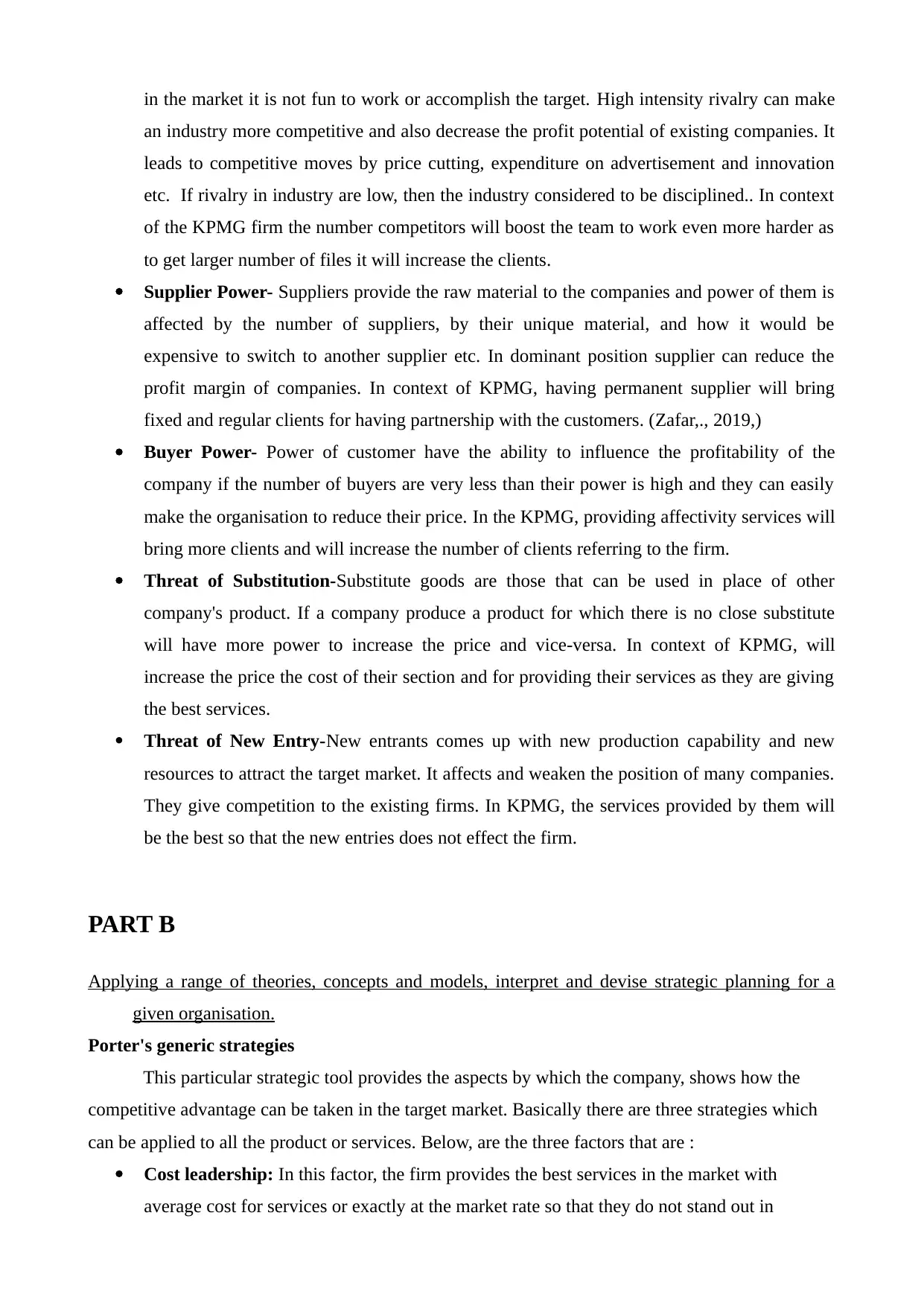
in the market it is not fun to work or accomplish the target. High intensity rivalry can make
an industry more competitive and also decrease the profit potential of existing companies. It
leads to competitive moves by price cutting, expenditure on advertisement and innovation
etc. If rivalry in industry are low, then the industry considered to be disciplined.. In context
of the KPMG firm the number competitors will boost the team to work even more harder as
to get larger number of files it will increase the clients.
Supplier Power- Suppliers provide the raw material to the companies and power of them is
affected by the number of suppliers, by their unique material, and how it would be
expensive to switch to another supplier etc. In dominant position supplier can reduce the
profit margin of companies. In context of KPMG, having permanent supplier will bring
fixed and regular clients for having partnership with the customers. (Zafar,., 2019,)
Buyer Power- Power of customer have the ability to influence the profitability of the
company if the number of buyers are very less than their power is high and they can easily
make the organisation to reduce their price. In the KPMG, providing affectivity services will
bring more clients and will increase the number of clients referring to the firm.
Threat of Substitution-Substitute goods are those that can be used in place of other
company's product. If a company produce a product for which there is no close substitute
will have more power to increase the price and vice-versa. In context of KPMG, will
increase the price the cost of their section and for providing their services as they are giving
the best services.
Threat of New Entry-New entrants comes up with new production capability and new
resources to attract the target market. It affects and weaken the position of many companies.
They give competition to the existing firms. In KPMG, the services provided by them will
be the best so that the new entries does not effect the firm.
PART B
Applying a range of theories, concepts and models, interpret and devise strategic planning for a
given organisation.
Porter's generic strategies
This particular strategic tool provides the aspects by which the company, shows how the
competitive advantage can be taken in the target market. Basically there are three strategies which
can be applied to all the product or services. Below, are the three factors that are :
Cost leadership: In this factor, the firm provides the best services in the market with
average cost for services or exactly at the market rate so that they do not stand out in
an industry more competitive and also decrease the profit potential of existing companies. It
leads to competitive moves by price cutting, expenditure on advertisement and innovation
etc. If rivalry in industry are low, then the industry considered to be disciplined.. In context
of the KPMG firm the number competitors will boost the team to work even more harder as
to get larger number of files it will increase the clients.
Supplier Power- Suppliers provide the raw material to the companies and power of them is
affected by the number of suppliers, by their unique material, and how it would be
expensive to switch to another supplier etc. In dominant position supplier can reduce the
profit margin of companies. In context of KPMG, having permanent supplier will bring
fixed and regular clients for having partnership with the customers. (Zafar,., 2019,)
Buyer Power- Power of customer have the ability to influence the profitability of the
company if the number of buyers are very less than their power is high and they can easily
make the organisation to reduce their price. In the KPMG, providing affectivity services will
bring more clients and will increase the number of clients referring to the firm.
Threat of Substitution-Substitute goods are those that can be used in place of other
company's product. If a company produce a product for which there is no close substitute
will have more power to increase the price and vice-versa. In context of KPMG, will
increase the price the cost of their section and for providing their services as they are giving
the best services.
Threat of New Entry-New entrants comes up with new production capability and new
resources to attract the target market. It affects and weaken the position of many companies.
They give competition to the existing firms. In KPMG, the services provided by them will
be the best so that the new entries does not effect the firm.
PART B
Applying a range of theories, concepts and models, interpret and devise strategic planning for a
given organisation.
Porter's generic strategies
This particular strategic tool provides the aspects by which the company, shows how the
competitive advantage can be taken in the target market. Basically there are three strategies which
can be applied to all the product or services. Below, are the three factors that are :
Cost leadership: In this factor, the firm provides the best services in the market with
average cost for services or exactly at the market rate so that they do not stand out in
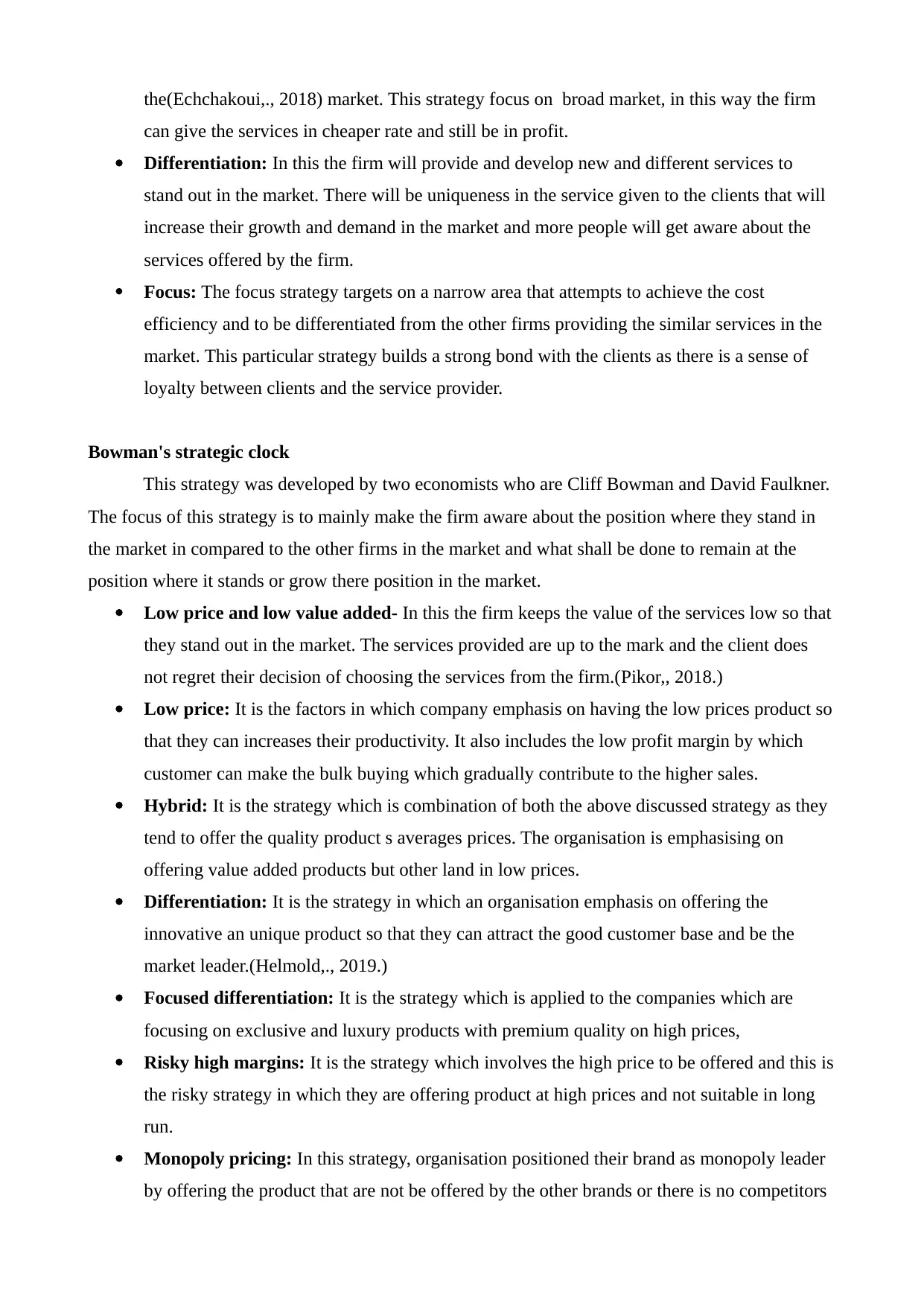
the(Echchakoui,., 2018) market. This strategy focus on broad market, in this way the firm
can give the services in cheaper rate and still be in profit.
Differentiation: In this the firm will provide and develop new and different services to
stand out in the market. There will be uniqueness in the service given to the clients that will
increase their growth and demand in the market and more people will get aware about the
services offered by the firm.
Focus: The focus strategy targets on a narrow area that attempts to achieve the cost
efficiency and to be differentiated from the other firms providing the similar services in the
market. This particular strategy builds a strong bond with the clients as there is a sense of
loyalty between clients and the service provider.
Bowman's strategic clock
This strategy was developed by two economists who are Cliff Bowman and David Faulkner.
The focus of this strategy is to mainly make the firm aware about the position where they stand in
the market in compared to the other firms in the market and what shall be done to remain at the
position where it stands or grow there position in the market.
Low price and low value added- In this the firm keeps the value of the services low so that
they stand out in the market. The services provided are up to the mark and the client does
not regret their decision of choosing the services from the firm.(Pikor,, 2018.)
Low price: It is the factors in which company emphasis on having the low prices product so
that they can increases their productivity. It also includes the low profit margin by which
customer can make the bulk buying which gradually contribute to the higher sales.
Hybrid: It is the strategy which is combination of both the above discussed strategy as they
tend to offer the quality product s averages prices. The organisation is emphasising on
offering value added products but other land in low prices.
Differentiation: It is the strategy in which an organisation emphasis on offering the
innovative an unique product so that they can attract the good customer base and be the
market leader.(Helmold,., 2019.)
Focused differentiation: It is the strategy which is applied to the companies which are
focusing on exclusive and luxury products with premium quality on high prices,
Risky high margins: It is the strategy which involves the high price to be offered and this is
the risky strategy in which they are offering product at high prices and not suitable in long
run.
Monopoly pricing: In this strategy, organisation positioned their brand as monopoly leader
by offering the product that are not be offered by the other brands or there is no competitors
can give the services in cheaper rate and still be in profit.
Differentiation: In this the firm will provide and develop new and different services to
stand out in the market. There will be uniqueness in the service given to the clients that will
increase their growth and demand in the market and more people will get aware about the
services offered by the firm.
Focus: The focus strategy targets on a narrow area that attempts to achieve the cost
efficiency and to be differentiated from the other firms providing the similar services in the
market. This particular strategy builds a strong bond with the clients as there is a sense of
loyalty between clients and the service provider.
Bowman's strategic clock
This strategy was developed by two economists who are Cliff Bowman and David Faulkner.
The focus of this strategy is to mainly make the firm aware about the position where they stand in
the market in compared to the other firms in the market and what shall be done to remain at the
position where it stands or grow there position in the market.
Low price and low value added- In this the firm keeps the value of the services low so that
they stand out in the market. The services provided are up to the mark and the client does
not regret their decision of choosing the services from the firm.(Pikor,, 2018.)
Low price: It is the factors in which company emphasis on having the low prices product so
that they can increases their productivity. It also includes the low profit margin by which
customer can make the bulk buying which gradually contribute to the higher sales.
Hybrid: It is the strategy which is combination of both the above discussed strategy as they
tend to offer the quality product s averages prices. The organisation is emphasising on
offering value added products but other land in low prices.
Differentiation: It is the strategy in which an organisation emphasis on offering the
innovative an unique product so that they can attract the good customer base and be the
market leader.(Helmold,., 2019.)
Focused differentiation: It is the strategy which is applied to the companies which are
focusing on exclusive and luxury products with premium quality on high prices,
Risky high margins: It is the strategy which involves the high price to be offered and this is
the risky strategy in which they are offering product at high prices and not suitable in long
run.
Monopoly pricing: In this strategy, organisation positioned their brand as monopoly leader
by offering the product that are not be offered by the other brands or there is no competitors
⊘ This is a preview!⊘
Do you want full access?
Subscribe today to unlock all pages.

Trusted by 1+ million students worldwide
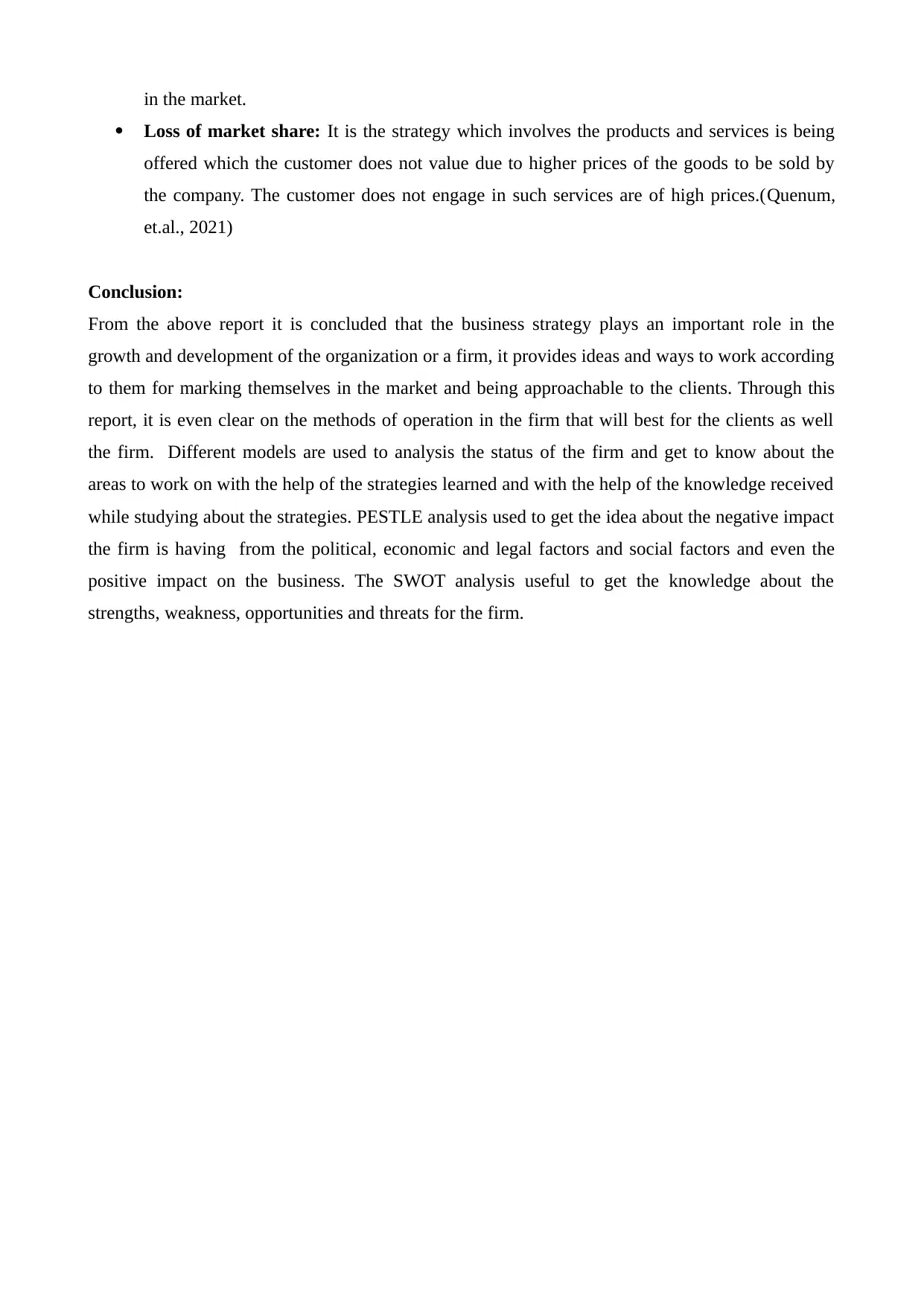
in the market.
Loss of market share: It is the strategy which involves the products and services is being
offered which the customer does not value due to higher prices of the goods to be sold by
the company. The customer does not engage in such services are of high prices.(Quenum,
et.al., 2021)
Conclusion:
From the above report it is concluded that the business strategy plays an important role in the
growth and development of the organization or a firm, it provides ideas and ways to work according
to them for marking themselves in the market and being approachable to the clients. Through this
report, it is even clear on the methods of operation in the firm that will best for the clients as well
the firm. Different models are used to analysis the status of the firm and get to know about the
areas to work on with the help of the strategies learned and with the help of the knowledge received
while studying about the strategies. PESTLE analysis used to get the idea about the negative impact
the firm is having from the political, economic and legal factors and social factors and even the
positive impact on the business. The SWOT analysis useful to get the knowledge about the
strengths, weakness, opportunities and threats for the firm.
Loss of market share: It is the strategy which involves the products and services is being
offered which the customer does not value due to higher prices of the goods to be sold by
the company. The customer does not engage in such services are of high prices.(Quenum,
et.al., 2021)
Conclusion:
From the above report it is concluded that the business strategy plays an important role in the
growth and development of the organization or a firm, it provides ideas and ways to work according
to them for marking themselves in the market and being approachable to the clients. Through this
report, it is even clear on the methods of operation in the firm that will best for the clients as well
the firm. Different models are used to analysis the status of the firm and get to know about the
areas to work on with the help of the strategies learned and with the help of the knowledge received
while studying about the strategies. PESTLE analysis used to get the idea about the negative impact
the firm is having from the political, economic and legal factors and social factors and even the
positive impact on the business. The SWOT analysis useful to get the knowledge about the
strengths, weakness, opportunities and threats for the firm.
Paraphrase This Document
Need a fresh take? Get an instant paraphrase of this document with our AI Paraphraser
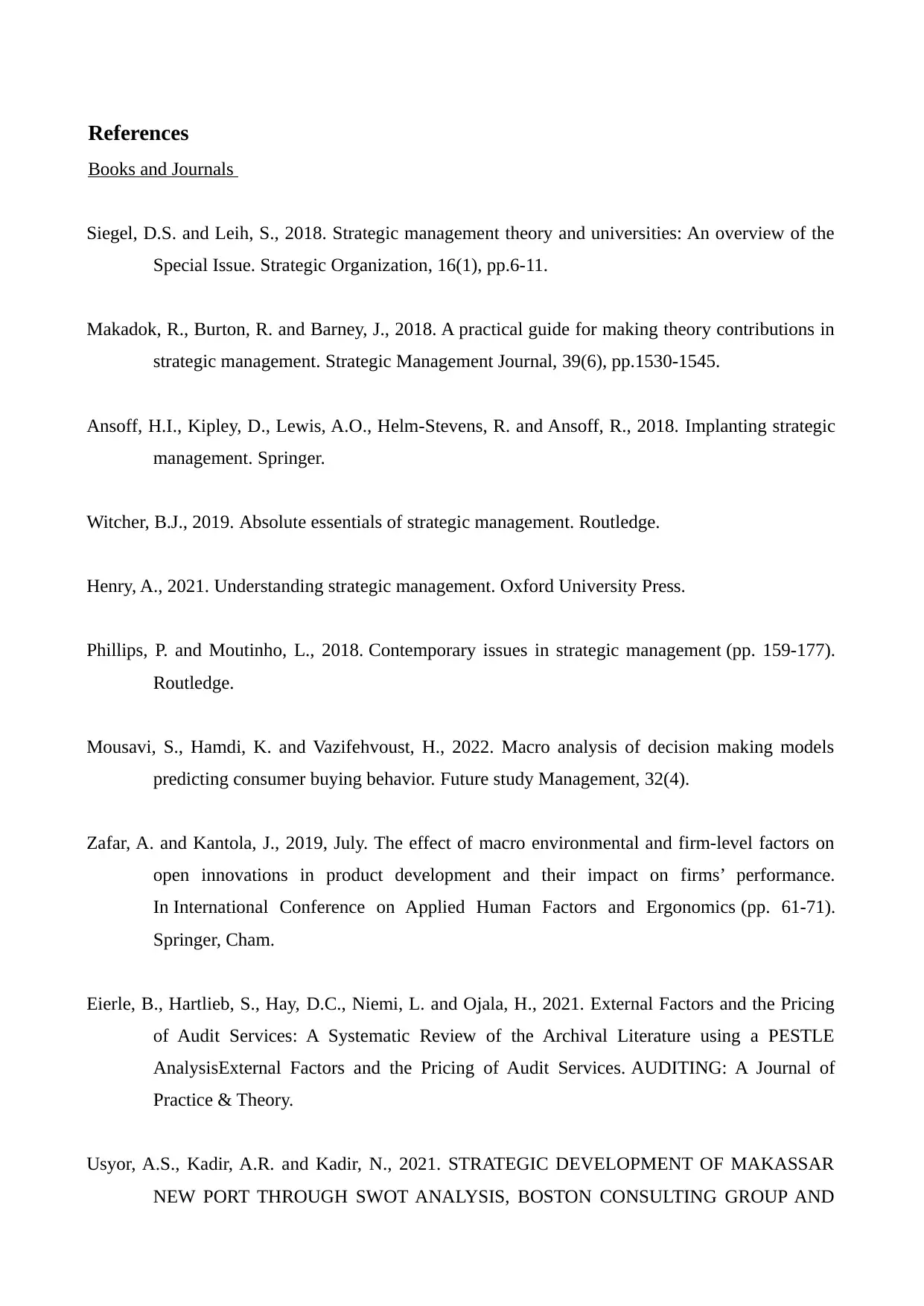
References
Books and Journals
Siegel, D.S. and Leih, S., 2018. Strategic management theory and universities: An overview of the
Special Issue. Strategic Organization, 16(1), pp.6-11.
Makadok, R., Burton, R. and Barney, J., 2018. A practical guide for making theory contributions in
strategic management. Strategic Management Journal, 39(6), pp.1530-1545.
Ansoff, H.I., Kipley, D., Lewis, A.O., Helm-Stevens, R. and Ansoff, R., 2018. Implanting strategic
management. Springer.
Witcher, B.J., 2019. Absolute essentials of strategic management. Routledge.
Henry, A., 2021. Understanding strategic management. Oxford University Press.
Phillips, P. and Moutinho, L., 2018. Contemporary issues in strategic management (pp. 159-177).
Routledge.
Mousavi, S., Hamdi, K. and Vazifehvoust, H., 2022. Macro analysis of decision making models
predicting consumer buying behavior. Future study Management, 32(4).
Zafar, A. and Kantola, J., 2019, July. The effect of macro environmental and firm-level factors on
open innovations in product development and their impact on firms’ performance.
In International Conference on Applied Human Factors and Ergonomics (pp. 61-71).
Springer, Cham.
Eierle, B., Hartlieb, S., Hay, D.C., Niemi, L. and Ojala, H., 2021. External Factors and the Pricing
of Audit Services: A Systematic Review of the Archival Literature using a PESTLE
AnalysisExternal Factors and the Pricing of Audit Services. AUDITING: A Journal of
Practice & Theory.
Usyor, A.S., Kadir, A.R. and Kadir, N., 2021. STRATEGIC DEVELOPMENT OF MAKASSAR
NEW PORT THROUGH SWOT ANALYSIS, BOSTON CONSULTING GROUP AND
Books and Journals
Siegel, D.S. and Leih, S., 2018. Strategic management theory and universities: An overview of the
Special Issue. Strategic Organization, 16(1), pp.6-11.
Makadok, R., Burton, R. and Barney, J., 2018. A practical guide for making theory contributions in
strategic management. Strategic Management Journal, 39(6), pp.1530-1545.
Ansoff, H.I., Kipley, D., Lewis, A.O., Helm-Stevens, R. and Ansoff, R., 2018. Implanting strategic
management. Springer.
Witcher, B.J., 2019. Absolute essentials of strategic management. Routledge.
Henry, A., 2021. Understanding strategic management. Oxford University Press.
Phillips, P. and Moutinho, L., 2018. Contemporary issues in strategic management (pp. 159-177).
Routledge.
Mousavi, S., Hamdi, K. and Vazifehvoust, H., 2022. Macro analysis of decision making models
predicting consumer buying behavior. Future study Management, 32(4).
Zafar, A. and Kantola, J., 2019, July. The effect of macro environmental and firm-level factors on
open innovations in product development and their impact on firms’ performance.
In International Conference on Applied Human Factors and Ergonomics (pp. 61-71).
Springer, Cham.
Eierle, B., Hartlieb, S., Hay, D.C., Niemi, L. and Ojala, H., 2021. External Factors and the Pricing
of Audit Services: A Systematic Review of the Archival Literature using a PESTLE
AnalysisExternal Factors and the Pricing of Audit Services. AUDITING: A Journal of
Practice & Theory.
Usyor, A.S., Kadir, A.R. and Kadir, N., 2021. STRATEGIC DEVELOPMENT OF MAKASSAR
NEW PORT THROUGH SWOT ANALYSIS, BOSTON CONSULTING GROUP AND
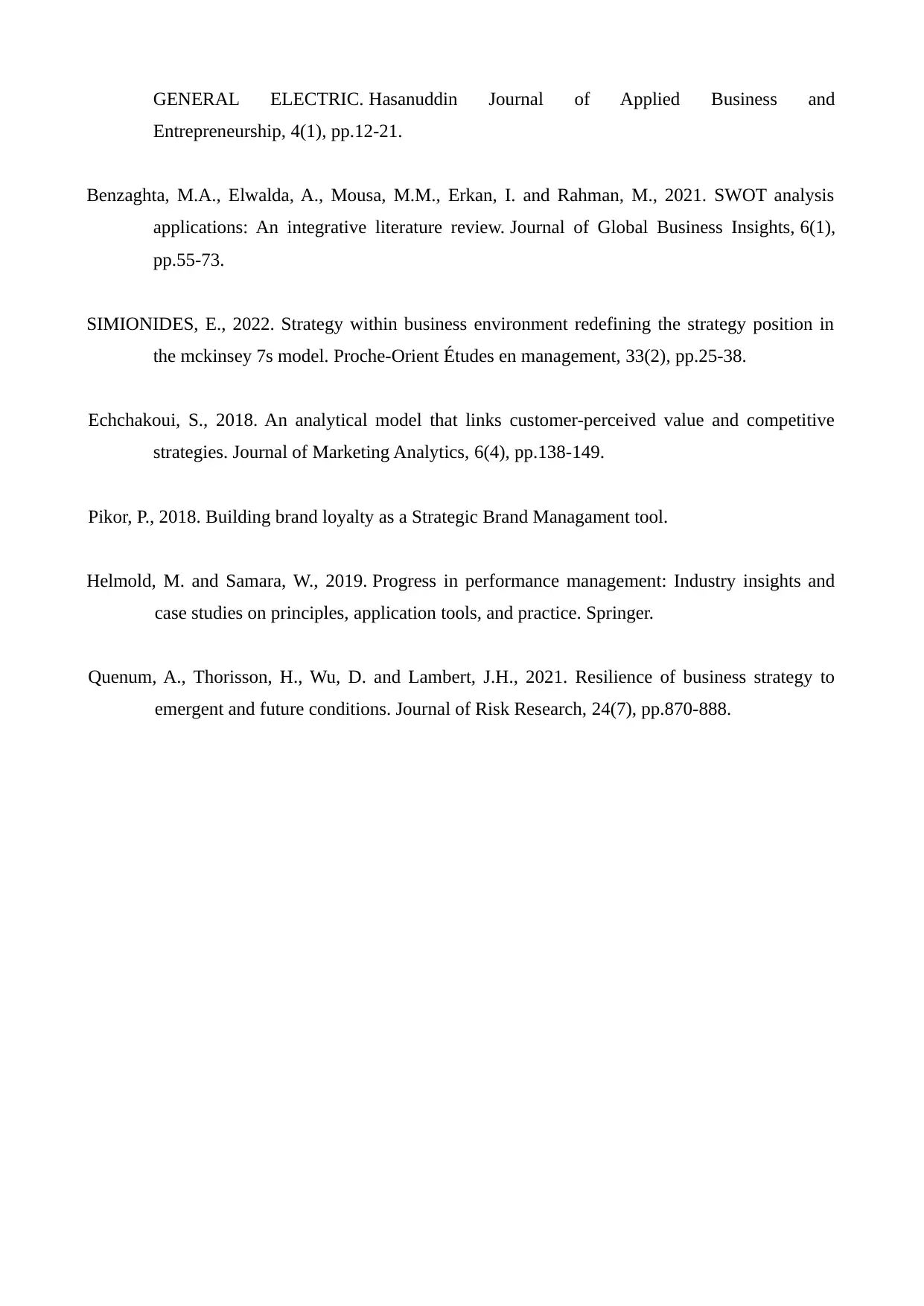
GENERAL ELECTRIC. Hasanuddin Journal of Applied Business and
Entrepreneurship, 4(1), pp.12-21.
Benzaghta, M.A., Elwalda, A., Mousa, M.M., Erkan, I. and Rahman, M., 2021. SWOT analysis
applications: An integrative literature review. Journal of Global Business Insights, 6(1),
pp.55-73.
SIMIONIDES, E., 2022. Strategy within business environment redefining the strategy position in
the mckinsey 7s model. Proche-Orient Études en management, 33(2), pp.25-38.
Echchakoui, S., 2018. An analytical model that links customer-perceived value and competitive
strategies. Journal of Marketing Analytics, 6(4), pp.138-149.
Pikor, P., 2018. Building brand loyalty as a Strategic Brand Managament tool.
Helmold, M. and Samara, W., 2019. Progress in performance management: Industry insights and
case studies on principles, application tools, and practice. Springer.
Quenum, A., Thorisson, H., Wu, D. and Lambert, J.H., 2021. Resilience of business strategy to
emergent and future conditions. Journal of Risk Research, 24(7), pp.870-888.
Entrepreneurship, 4(1), pp.12-21.
Benzaghta, M.A., Elwalda, A., Mousa, M.M., Erkan, I. and Rahman, M., 2021. SWOT analysis
applications: An integrative literature review. Journal of Global Business Insights, 6(1),
pp.55-73.
SIMIONIDES, E., 2022. Strategy within business environment redefining the strategy position in
the mckinsey 7s model. Proche-Orient Études en management, 33(2), pp.25-38.
Echchakoui, S., 2018. An analytical model that links customer-perceived value and competitive
strategies. Journal of Marketing Analytics, 6(4), pp.138-149.
Pikor, P., 2018. Building brand loyalty as a Strategic Brand Managament tool.
Helmold, M. and Samara, W., 2019. Progress in performance management: Industry insights and
case studies on principles, application tools, and practice. Springer.
Quenum, A., Thorisson, H., Wu, D. and Lambert, J.H., 2021. Resilience of business strategy to
emergent and future conditions. Journal of Risk Research, 24(7), pp.870-888.
⊘ This is a preview!⊘
Do you want full access?
Subscribe today to unlock all pages.

Trusted by 1+ million students worldwide
1 out of 12
Related Documents
Your All-in-One AI-Powered Toolkit for Academic Success.
+13062052269
info@desklib.com
Available 24*7 on WhatsApp / Email
![[object Object]](/_next/static/media/star-bottom.7253800d.svg)
Unlock your academic potential
Copyright © 2020–2025 A2Z Services. All Rights Reserved. Developed and managed by ZUCOL.




